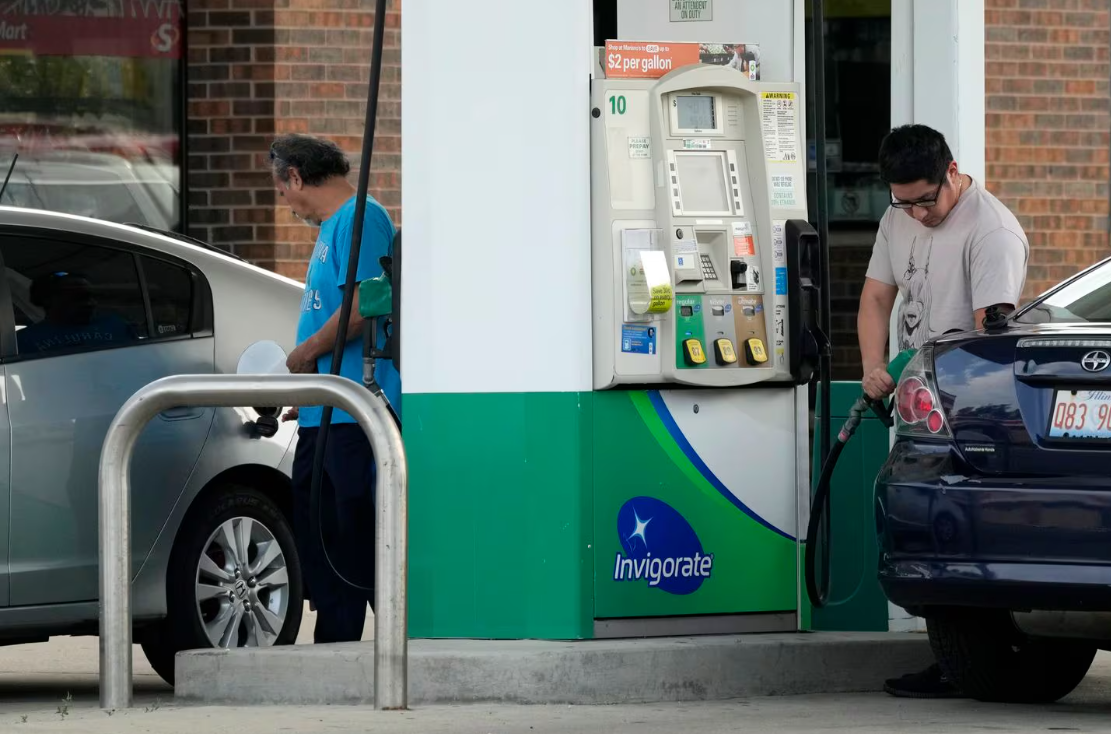美国收紧汽车里程限制,作为应对气候变化战略的一部分

【中美创新时报2024 年 6 月 8 日编译讯】(记者温友平编译)根据拜登政府周五(7日)公布的新联邦规定,到 2031 年,在美国销售的新车在实际驾驶中的平均行驶里程必须达到每加仑 38 英里左右,高于今年的 29 英里/加仑。美联社记者马修·戴利(MATTHEW DALY)对此作了下述报道。
根据美国国家公路交通安全管理局发布的要求,最终规定将使 2027 年至 2031 年款乘用车的燃油经济性每年提高 2%,而 SUV 和其他轻型卡车的燃油经济性将使 2029 年至 2031 年款每年提高 2%。
最终数字低于去年发布的一项提案。政府官员表示,要求不那么严格将使汽车行业能够灵活地专注于电动汽车,并补充说,更高的油耗要求将给消费者带来巨大的成本,而没有足够的燃油节省来抵消这些成本。
拜登总统设定了一个目标,即到 2030 年,美国销售的新车中有一半是电动汽车,这是他应对气候变化的努力的一部分。汽油驱动的汽车是美国温室气体排放的最大单一来源。
50% 的销售数字将比目前的电动汽车销量大幅增加,去年电动汽车占新车销量的 7.6%,高于 2022 年的 5.8%。
拜登在推广电动汽车的同时,也需要汽车行业的合作和汽车工人的政治支持,汽车工人是一个关键的政治投票集团,因为这位民主党总统将在 11 月寻求连任。全美汽车工人联合会支持拜登,但表示希望确保向电动汽车的过渡不会导致失业,并确保该行业向制造电动汽车和电池的工人支付最高工资。
拜登的可能对手、前总统唐纳德·特朗普和其他共和党人谴责拜登推动电动汽车的发展对消费者不公平,是政府越权的例子。
拜登政府表示,到 2050 年,新标准将节省近 700 亿加仑汽油,到本世纪中叶可防止超过 7.1 亿公吨的二氧化碳排放。
交通部长皮特·布蒂吉格(Pete Buttigieg)在一份声明中表示:“这些新标准不仅可以节省美国人每次加油的油费,还可以减少有害污染,减少美国对外国石油的依赖。”“这些标准将为车主在车辆的整个使用寿命内节省 600 多美元的汽油费用。”
公路安全局表示,它已试图调整其法规,使其与环境保护局新出台的收紧尾气排放标准的规定相一致。但如果存在差异,汽车制造商很可能不得不遵守最严格的规定。
在错综复杂的政府监管世界中,这两个机构基本上都负责制定燃油经济性要求,因为减少温室气体排放的最快方法是减少汽油燃烧。
美联社使用的燃油经济性数据反映了现实世界的驾驶条件,包括风阻、山丘和空调使用等因素。由于这些因素,现实世界的数字低于 NHTSA 提出的里程标准。
“这些新的燃油经济性标准将为我们的国家节省数十亿美元,帮助减少我们对化石燃料的依赖,并为每个人提供更清洁的空气,”NHTSA 副局长索菲·舒尔曼说。
领先的行业组织汽车创新联盟总裁兼首席执行官约翰·博泽拉(John Bozzella)表示,拜登政府“似乎已经制定了一项与最近其他联邦尾气排放规则相适应的 CAFE 规则。”博泽拉使用的是燃油标准的首字母缩写,正式名称为企业平均燃油经济性规则。
“在某个时候,”博泽拉补充道,“我们需要讨论在汽车快速走向电气化的世界里,是否真的需要 CAFE(标准)。
博泽拉说,燃油经济性标准是“20 世纪 70 年代的遗物,是一项通过提高内燃机汽车的效率来促进能源节约和能源独立的政策。但这些汽车已经非常高效了。而且电动汽车不会燃烧任何东西。它们甚至没有排气管。”
环境组织生物多样性中心的丹·贝克尔(Dan Becker )抨击新规则不充分。
公路安全局表示,它已努力调整其法规,使其与环境保护局新出台的严格尾气排放标准的规定相一致。但如果存在差异,汽车制造商可能必须遵守最严格的法规。
在错综复杂的政府监管世界中,两个机构基本上都负责制定燃油经济性要求,因为减少温室气体排放的最快方法是燃烧更少的汽油。
美联社使用的燃油经济性数据反映了现实世界的驾驶条件,包括风阻、山丘和空调使用等因素。由于这些因素,现实世界的数字低于国家公路交通安全管理局提出的里程标准。
“这些新的燃油经济性标准将为我们的国家节省数十亿美元,帮助减少我们对化石燃料的依赖,并为每个人提供更清洁的空气,”国家公路交通安全管理局副局长索菲·舒尔曼(Sophie Shulman)说。
领先的行业组织汽车创新联盟 (Alliance for Automotive Innovation) 总裁兼首席执行官约翰·博泽拉 (John Bozzella) 表示,拜登政府“似乎已经制定了一项与近期其他联邦尾气排放规则相兼容的 CAFE 规则”。博泽拉使用的是燃油标准的首字母缩写,正式名称为企业平均燃油经济性规则。
“在某个时候,”博泽拉补充道,“我们需要讨论在汽车快速走向电气化的世界里,是否真的需要 CAFE(标准)。
博泽拉说,燃油经济性标准是“20 世纪 70 年代的遗物,是一项通过提高内燃机汽车的效率来促进能源节约和能源独立的政策。但这些汽车已经非常高效了。而且电动汽车不会燃烧任何东西。它们甚至没有排气管。”
环保组织生物多样性中心的丹·贝克尔(Dan Becker )抨击新规定不充分。
他说,公路安全局本应为燃气汽车制定严格的标准,“但它却对排气管视而不见,让汽车制造商自由地制造轿车、SUV 和皮卡,这些汽车将在未来几十年内消耗大量燃油并造成污染,让美国继续依赖石油。”
政府“屈服于汽车制造商的压力,制定了一项软弱的规定,只要求 2%贝克尔表示,该规则没有达到该机构自身设定的燃油经济性标准在技术上可行的最高水平的要求。
NHTSA 表示,其规则包括商用皮卡和工作货车每年 10% 的燃油经济性改进。汽车制造商可以通过混合使用电动汽车、油电混合动力汽车以及提高汽油和柴油汽车的效率来满足要求。
题图:人们在伊利诺伊州惠灵的加油站给车辆加满油后检查了油箱。NAM Y. HUH/美联社
附原英文报道:
Real-world mileage standard for new vehicles rising to 38 miles per gallon in 2031 under new Biden rule
By MATTHEW DALY The Associated Press,Updated June 7, 2024
WASHINGTON — New vehicles sold in the US will have to average about 38 miles per gallon of gasoline in 2031 in real-world driving, up from about 29 mpg this year, under new federal rules unveiled Friday by the Biden administration.
The final rule will increase fuel economy by 2 percent per year for model years 2027 to 2031 for passenger cars, while SUVs and other light trucks will increase by 2 percent per year for model years 2029 to 2031, according to requirements released by the National Highway Traffic Safety Administration.
The final figures are below a proposal released last year. Administration officials said the less strict requirements will allow the auto industry flexibility to focus on electric vehicles, adding that higher gas-mileage requirements would have imposed significant costs on consumers without sufficient fuel savings to offset them.
President Joe Biden has set a goal that half all of new vehicles sold in the US in 2030 are electric, part of his push to fight climate change. Gasoline-powered vehicles make up the largest single source of US greenhouse gas emissions.
The 50 percent sales figure would be a huge increase over current EV sales, which rose to 7.6 percent of new vehicle sales last year, up from 5.8 percent in 2022.
Even as he promotes EVs, Biden needs cooperation from the auto industry and political support from auto workers, a key political voting bloc, as the Democratic president seeks reelection in November. The United Auto Workers union has endorsed Biden but has said it wants to make sure the transition to electric vehicles does not cause job losses and that the industry pays top wages to workers who build EVs and batteries.
Biden’s likely opponent, former President Donald Trump, and other Republicans have denounced Biden’s push for EVs as unfair for consumers and an example of government overreach.
The new standards will save almost 70 billion gallons of gasoline through 2050, preventing more than 710 million metric tons of carbon dioxide emissions by midcentury, the Biden administration said.
“Not only will these new standards save Americans money at the pump every time they fill up, they will also decrease harmful pollution and make America less reliant on foreign oil,” Transportation Secretary Pete Buttigieg said in a statement. “These standards will save car owners more than $600 in gasoline costs over the lifetime of their vehicle.”
The highway safety agency said it has sought to line up its regulations so they match new Environmental Protection Agency rules that tighten standards for tailpipe emissions. But if there are discrepancies, automakers likely will have to follow the most stringent regulation.
In the byzantine world of government regulation, both agencies essentially are responsible for setting fuel economy requirements since the fastest way to reduce greenhouse emissions is to burn less gasoline.
Fuel economy figures used by The Associated Press reflect real-world driving conditions that include factors such as wind resistance, hills and use of air-conditioning. Because of those factors, the real-world numbers are lower than the mileage standard put forward by NHTSA.
“These new fuel economy standards will save our nation billions of dollars, help reduce our dependence on fossil fuels and make our air cleaner for everyone,” said NHTSA Deputy Administrator Sophie Shulman.
John Bozzella, president and CEO of the Alliance for Automotive Innovation, a leading industry group, said the Biden administration “appears to have landed on a CAFE rule that works with the other recent federal tailpipe rules.” Bozzella was using an acronym for the fuel standards, which are officially known as the corporate average fuel economy rules.
“At some point,” Bozzella added, ”we’ll need to talk about whether there’s really a need for CAFE (standards) in a world rapidly moving toward electrification” of the vehicle fleet.
The fuel-economy standards are “a relic of the 1970s,” Bozzella said, “a policy to promote energy conservation and energy independence by making internal combustion vehicles more efficient. But those vehicles are already very efficient. And EVs don’t combust anything. They don’t even have a tailpipe.”
Dan Becker at the Center for Biological Diversity, an environmental group, slammed the new rules as inadequate.
The highway safety agency said it has sought to line up its regulations so they match new Environmental Protection Agency rules that tighten standards for tailpipe emissions. But if there are discrepancies, automakers likely will have to follow the most stringent regulation.
In the byzantine world of government regulation, both agencies essentially are responsible for setting fuel economy requirements since the fastest way to reduce greenhouse emissions is to burn less gasoline.
Fuel economy figures used by The Associated Press reflect real-world driving conditions that include factors such as wind resistance, hills and use of air-conditioning. Because of those factors, the real-world numbers are lower than the mileage standard put forward by NHTSA.
“These new fuel economy standards will save our nation billions of dollars, help reduce our dependence on fossil fuels and make our air cleaner for everyone,” said NHTSA Deputy Administrator Sophie Shulman.
John Bozzella, president and CEO of the Alliance for Automotive Innovation, a leading industry group, said the Biden administration “appears to have landed on a CAFE rule that works with the other recent federal tailpipe rules.” Bozzella was using an acronym for the fuel standards, which are officially known as the corporate average fuel economy rules.
“At some point,” Bozzella added, ”we’ll need to talk about whether there’s really a need for CAFE (standards) in a world rapidly moving toward electrification” of the vehicle fleet.
The fuel-economy standards are “a relic of the 1970s,” Bozzella said, “a policy to promote energy conservation and energy independence by making internal combustion vehicles more efficient. But those vehicles are already very efficient. And EVs don’t combust anything. They don’t even have a tailpipe.”
Dan Becker at the Center for Biological Diversity, an environmental group, slammed the new rules as inadequate.
The highway safety agency is supposed to set strong standards for gas-powered vehicles, he said, “but instead it sat on its tailpipes, leaving automakers free to make cars, SUVs and pickups that will guzzle and pollute for decades to come and keep America stuck on oil.”
The administration “caved to automaker pressure, with a weak rule requiring only a 2 percent improvement” per year in fuel economy, Becker said, adding that the rule falls short of the agency’s own requirement to set fuel-economy standards at the maximum technologically feasible level.
NHTSA said its rule includes a 10 percent improvement per year for commercial pickup trucks and work vans. Automakers can meet the requirements with a mix of electric vehicles, gas-electric hybrids and efficiency improvements in gas and diesel vehicles.



